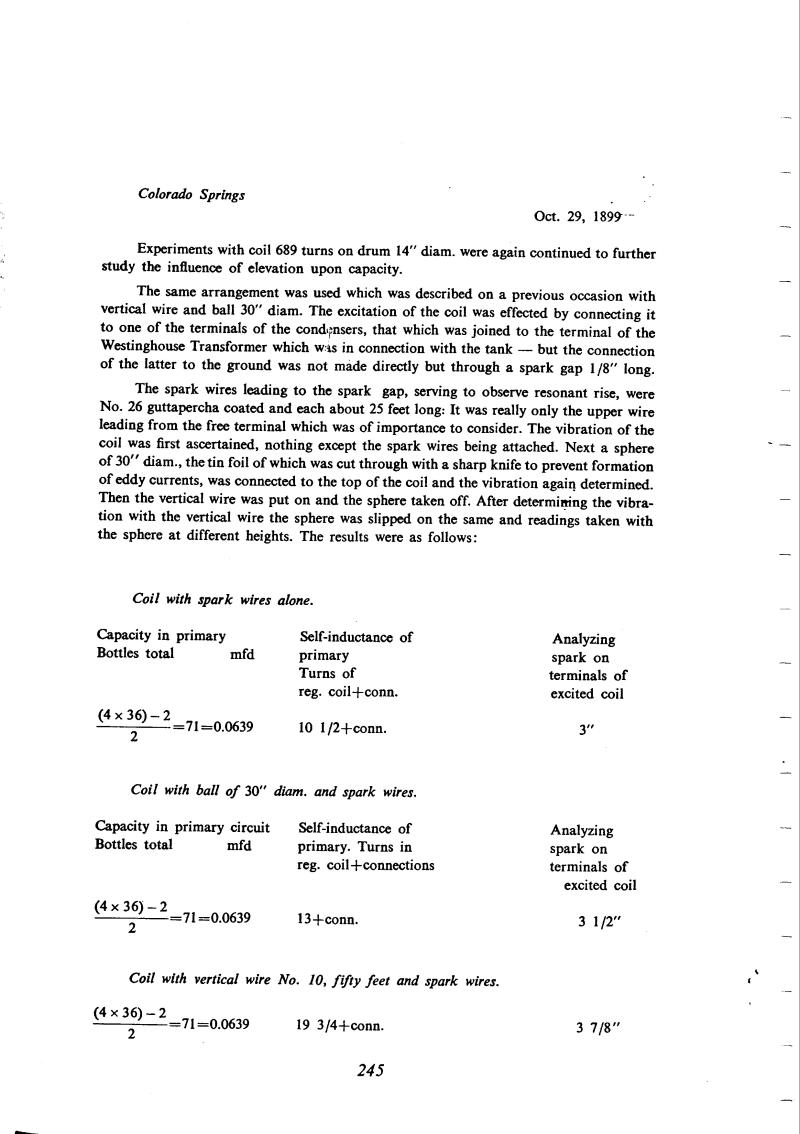
Nikola Tesla Books
Colorado Springs
Oct. 29, 1899
Experiments with coil 689 turns on drum 14" diam. were again continued to further study the influence of elevation upon capacity.
The same arrangement was used which was described on a previous occasion with vertical wire and ball 30" diam. The excitation of the coil was effected by connecting it to one of the terminals of the condensers, that which was joined to the terminal of the Westinghouse Transformer which was in connection with the tank - but the connection of the latter to the ground was not made directly but through a spark gap 1/8" long.
The spark wires leading to the spark gap, serving to observe resonant rise, were No. 26 guttapercha coated and each about 25 feet long: It was really only the upper wire leading from the free terminal which was of importance to consider. The vibration of the coil was first ascertained, nothing except the spark wires being attached. Next a sphere of 30" diam., the tin foil of which was cut through with a sharp knife to prevent formation of eddy currents, was connected to the top of the coil and the vibration again determined. Then the vertical wire was put on and the sphere taken off. After determining the vibration with the vertical wire the sphere was slipped on the same and readings taken with the sphere at different heights. The results were as follows:
Coil with spark wires alone.
| Capacity in primary | Self-inductance of primary Turns of reg. coil + conn. | Analyzing spark on terminals of excited coil | |
|---|---|---|---|
| Bottles total | mfd | ||
| $! {{\left({4 \times 36}\right) - 2} \over 2} $! = 71 | = 0.0639 | 10 1/2+conn. | 3" |
Coil with ball of 30" diam. and spark wires.
| Capacity in primary circuit | Self-inductance of primary. Turns in reg. coil + connections | Analyzing spark on terminals of excited coil | |
|---|---|---|---|
| Bottles total | mfd | ||
| $! {{\left({4 \times 36}\right) - 2} \over 2} $! = 71 | = 0.0639 | 13 + conn. | 3 1/2" |
Coil with vertical wire No. 10, fifty feet and spark wires.
| Capacity in primary circuit | Self-inductance of primary. Turns in reg. coil + connections | Analyzing spark on terminals of excited coil | |
|---|---|---|---|
| Bottles total | mfd | ||
| $! {{\left({4 \times 36}\right) - 2} \over 2} $! = 71 | = 0.0639 | 19 3/4 + conn. | 3 7/8" |
245
October 29
His remark about eddy currents in the sphere is interesting. To prevent their formation he slit the tinfoil with a knife. Did he assume that in the vicinity of the coil the sphere would behave like a short-circuited turn? It is readily shown that if this effect is pronounced (and not taken into account) the measured capacity of the sphere will be too low. This might be an explanation for the reduction of the effective capacity of the sphere in the lowest position (see the calculation of October 28th for an 18" sphere in the lowest position).
October 29
It contains a new measurement series with larger sphere and somewhat changed excitation of the measurement circuit. The excitation is now regulated by an adjustable arcing gap between the lower coil L terminal and grounding (for other details of the scheme please see Oct. 23). The note related to eddy-currents on the globe is very interesting. In order to prevent the occurrence of these currents Tesla makes slits in the metal foil by knife. Did Tesla assume that the sphere in the vicinity of the coil acts like a short circuited turn or something similar? If this effect is distinct and neglected, it is easy to show that the measure value for the sphere will be smaller than actual. It is possible that this effect causes the effective globe capacitance reduction in the lowest position (please see the calculated value obtained on Oct. 28 for the sphere of 18" diameter in the lowest position.)
In some cases Tesla finds that the resonance adjustment is not sharp. By calculation he checks the coil validity factor. The actual validity factor is certainly smaller because Tesla takes the coil resistance at direct current.

